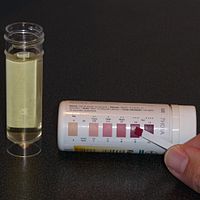
Photo from wikipedia
Brassica carinata is a new oilseed crop in Florida with the potential of producing high-quality jet biofuel. A high-protein meal (~40% crude protein; CP) is obtained as a byproduct of… Click to show full abstract
Brassica carinata is a new oilseed crop in Florida with the potential of producing high-quality jet biofuel. A high-protein meal (~40% crude protein; CP) is obtained as a byproduct of oil extraction; however, limited research is available on the utilization of this meal as a protein supplement for beef cattle. A generalized randomized block design was used to evaluate the effects of supplementation with B. carinata meal pellets on performance and attainment of puberty in growing beef heifers consuming bermudagrass hay (Cynodon dactylon) ad libitum. Sixty-four Angus crossbred heifers (240 ± 39 kg initial body weight; BW) were stratified and blocked (2 blocks: light and heavy) by initial BW and randomly allocated into 18 pens over 2 consecutive yr (10 in yr 1 and 8 in yr 2). Within block, pens were randomly assigned to one of two treatments: 0 (CTL) or 0.3% of BW/d (as fed) of B. carinata meal pellets (BCM). Blood samples and BW were collected weekly for 70 d, before daily supplementation. Data were analyzed using PROC MIXED of SAS with repeated measures. Model included the fixed effects of treatment, day, treatment × day interactions, block, and block × treatment interactions, with the random effect of year. Plasma was analyzed for concentrations of progesterone, triiodothyronine (T3), thyroxine (T4), ceruloplasmin (Cp), and haptoglobin (Hp). An effect of treatment was observed (P ˂ 0.01) for ADG between CTL (0.14 kg) and BCM (0.42 kg). There was no treatment or block (P > 0.05) effect for concentrations of T3, T4 or Hp; however, there was an effect of day (P < 0.01) for T3, T4, and Cp. An effect of treatment (P ˂ 0.01) was observed for Cp, with CTL having greater concentrations compared with BCM. Time to attainment of puberty did not differ (P = 0.93) between treatments. Feeding B. carinata meal as a protein supplement at 0.3% of BW/d is a viable option for increasing ADG of growing beef heifers, without affecting attainment of puberty, thyroid hormone status, or eliciting an acute phase response.
Journal Title: Journal of animal science
Year Published: 2019
Link to full text (if available)
Share on Social Media: Sign Up to like & get
recommendations!